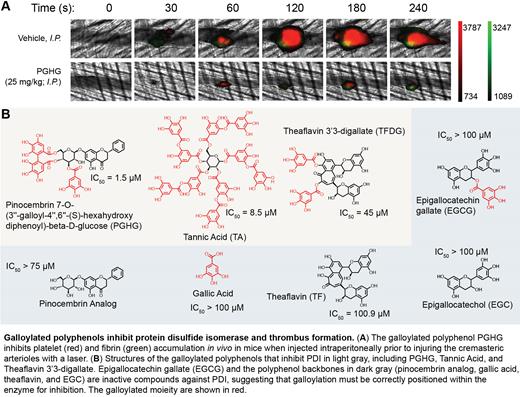Protein disulfide isomerase (PDI) family thiol isomerases are multidomain oxidoreductases that function in thrombus formation. PDI antagonism or targeted genetic deletion blocks thrombus formation in several murine models of thrombosis. PDI has a domain structure of a-b-b'-a' in which the a and a' domains contain the Cys-Gly-His-Cys catalytic motifs responsible for disulfide shuffling and the b and b' domains are the substrate binding domains. We have previously identified flavonoid quercetins and bepristats as two structure independent classes of PDI inhibitors that act by binding the hydrophobic pocket in the b' domain and eliciting allosteric modifications that impair oxidoreductase activity. While screening a flavonoid library for inhibitors of the SARS-CoV-2 main protease (Mpro), we identified a Mpro inhibitor termed PGHG that blocked PDI reductase activity with an IC 50 of 1.5+0.6 µM. When tested against isolated domains of PDI, PGHG inhibited a and a' fragments as well as ab, b'xa' and abb'x fragments, indicating that it acts on the a and a' domains of PDI. Supportive of an activity at the a and/or a' domains, PGHG inhibited other vascular thiol isomerases including ERp5, ERp46, ERp57, and ERp72 with IC 50s of 1.5, 3.9, 3.3, and 7.8 µM, respectively. When tested in a cremaster muscle murine model of thrombus formation, PGHG (25 mg/kg) inhibited platelet accumulation to 18+6% of control levels and fibrin formation to 21+3% of controls (Fig. 1). In contrast, when tested in the mice tail transection model of bleeding, PGHG did not prolong the time to cessation of bleeding nor the total amount of blood loss. These results show that PGHG can inhibit thrombus formation without promoting bleeding.
To better understand the mechanism by which PGHG inhibits PDI, we evaluated other galloylated polyphenols for their ability to inhibit PDI (Fig. 2). These studies identified galloylated polyphenols with structurally unrelated backbones, including theaflavin 3-3'-digallate (TFDG) and tannic acid (TA), that inhibited PDI. In contrast, related galloylated analogs such as epigallocatechin gallate (EGCG), and epicatechin-3-gallate (EGC) did not inhibit PDI. Similarly, the isolated backbones of active compounds, including pinocembrin (backbone of PGHG), theaflavin (backbone of TFDG), and gallate (backbone of TA) failed to inhibit PDI. Like PGHG, TFDG inhibited isolated a and a' fragments as well as ab, b'xa' and abb'x fragments, indicating that it, like PGHG, acts on the a and a' domains of PDI. These structure-activity relationships show that a subgroup of galloylated polyphenols can inhibit PDI via interactions with the a and/or a' domains.
Thrombosis is a common complication of COVID19. Our evaluation of plasma PDI levels in patients with mild (n = 16), moderate (n = 21), and severe (n = 23) COVID19 showed that PDI levels increase according to the level of disease severity. Since previous studies have identified galloylated polyphenols that inhibit SARS-CoV-2 replication in vitro and in vivo (Furukawa, Sci Rep, 2021), we evaluated the PGHG for its ability to inhibit the proteolytic activity of SARS-CoV-2 Mpro and to block SARS-CoV-2 in a Vero E6-based viral replication assay. PGHG inhibited Mpro with an IC 50 of 6.5 µM and SARS-CoV-2 replication with an IC 50 of 4.9 µM. To better understand the interaction of PGHG with Mpro, we performed all-atom, explicit water molecular dynamic simulations . These simulations showed an overall binding energy (ΔG total) of -58.64+3.17 and demonstrated hydrogen bonding between the galloyl group of PGHG and Mpro Cys145, the active site cysteine of the protease. Similarly, published molecular dynamic simulations of TA with Mpro show hydrogen bonding of TA with Mpro Cys145 (Haddad et al., Int J Mol Sci, 2022). These observations suggest a mechanism wherein steric interactions of select galloylated polyphenols position a galloyl group for interactions with active site cysteines, as occur in both PDI and Mpro, inhibiting their activity. These studies thus identify a group of orally available galloylated polyphenols that modify vascular thiol isomerases, inhibit thrombus formation, and block SARS-CoV-2 replication. Galloyltransferases are found in many plants and galloylated polyphenols are abundant in commonly consumed beverages such as teas. Members of this class of compounds may be useful in the setting of COVID19 as inhibitors of thrombosis and viral replication.
Disclosures
Flaumenhaft:Xap Therapeutics: Consultancy; Versiti Blood Research Center: Membership on an entity's Board of Directors or advisory committees; Function Therapeutics: Membership on an entity's Board of Directors or advisory committees; Cleveland KUH- Training network: Honoraria, Membership on an entity's Board of Directors or advisory committees; Platelet Diagnostics: Consultancy, Current equity holder in private company, Patents & Royalties; Porosome Therapeutics: Current equity holder in private company, Membership on an entity's Board of Directors or advisory committees.


This feature is available to Subscribers Only
Sign In or Create an Account Close Modal